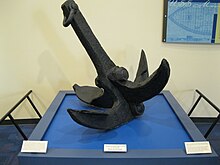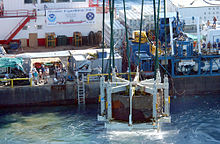From Wikipedia"
USS Monitor was an iron-hulled steamship. Built during the American Civil War, she was the first ironclad warship commissioned by the Union Navy. Monitor is most famous for her central role in the Battle of Hampton Roads on 9 March 1862, where, under the command of Lieutenant John Worden, she fought the casemate ironclad CSS Virginia (built on the hull of the former steam frigate USS Merrimack) to a standstill. The unique design of the ship, distinguished by its revolving turret which was designed by American inventor Theodore Timby, was quickly duplicated and established the monitor type of warship.
The remainder of the ship was designed by the Swedish-born engineer and inventor John Ericsson and hurriedly built in Brooklyn in only 101 days. Monitor presented a new concept in ship design and employed a variety of new inventions and innovations in ship building that caught the attention of the world. The impetus to build Monitor was prompted by the news that the Confederates were building an ironclad warship, named Virginia, that could effectively engage the Union ships blockading Hampton Roads and the James River leading to Richmond and ultimately advance on Washington, D.C. and other cities, virtually unchallenged. Before Monitor could reach Hampton Roads, the Confederate ironclad had destroyed the sail frigates USS Cumberland and USS Congress and had run the steam frigate USS Minnesota aground. That night Monitor arrived and the following morning, just as Virginia set to finish off Minnesota, the new Union ironclad confronted the Confederate ship, preventing her from wreaking further destruction on the wooden Union ships. A four-hour battle ensued, both ships pounding the other with close-range cannon fire, although neither ship could destroy or seriously damage the other. This was the first-ever battle fought between two armored warships and marked a turning point in naval warfare.
After the Confederates were forced to destroy Virginia as they withdrew in early May, Monitor sailed up the James River to support the Union Army during the Peninsula Campaign. The ship participated in the Battle of Drewry's Bluff later that month and remained in the area giving support to General McClellan's forces on land until she was ordered to join the blockaders off North Carolina in December. On her way there she foundered while under tow, during a storm off Cape Hatteras on the last day of the year. Monitor's wreck was discovered in 1973 and has been partially salvaged. Her guns, gun turret, engine and other relics are on display at the Mariners' Museum in Newport News, Virginia.
The Navy tested an "underwater locator" in August 1949 by searching an area south of the Cape Hatteras Lighthouse for the wreck of Monitor. It found a 140-foot (42.7 m) long object bulky enough to be a shipwreck, in 310 feet (94.5 m) feet of water that was thought to be Monitor, but powerful currents negated attempts by divers to investigate. Retired Rear Admiral Edward Ellsberg proposed using external pontoons to raise the wreck in 1951, the same method of marine salvage he had used on the sunken submarine S-51, for the cost of $250,000. Four years later, Robert F. Marx claimed to have discovered the wreck based on the idea she had drifted into shallow water north of the lighthouse before sinking. Marx said he had dived on the wreck and placed a Coke bottle with his name on it in one of the gun barrels, although he never provided any proof of his story.
Interest in locating the ship revived in the early 1970s and Duke University, the National Geographic Society and the National Science Foundation sponsored an expedition in August 1973 to search for the wreck using a towed sonar system. The Duke team was led by John G. Newton (no known relation to the Isaac Newton that served on the Monitor). On 27 August, Monitor was discovered 111 years after sinking, near Cape Hatteras at coordinates 35°0′6″N 75°24′23″WCoordinates: 35°0′6″N 75°24′23″W. They sent a camera down to photograph the wreck, but the pictures were so fuzzy as to be useless; on a second attempt the camera snagged something on the wreck and was lost. The sonar images did not match what they expected the wreck to look like until they realized that the sinking vessel had turned over while descending and was resting at the bottom upside down. The team announced their discovery on 8 March 1974. Another expedition was mounted that same month to confirm the discovery and the research submersible Alcoa Sea Probe was able to take still photos and video of the wreck that confirmed it was Monitor.
These photos revealed that the wreck was disintegrating and the discovery raised another issue. Since the Navy had formally abandoned the wreck in 1953, it could be exploited by divers and private salvage companies as it lay outside North Carolina's territorial limits. To preserve the ship, the wreck, and everything around it, a .5-nautical-mile (0.93 km; 0.58 mi) radius was designated as the Monitor National Marine Sanctuary, the first U.S. marine sanctuary, on 30 January 1975. Monitor was also designated a National Historic Landmark on 23 June 1986.
USS Monitor anchor at the Mariners' Museum
Initial efforts in 1995 by Navy and NOAA divers to raise the warship's propeller were foiled by an abnormally stormy season off Cape Hatteras. Realizing that raising the whole wreck was impractical for financial reasons as well as the inability to bring up the wreck intact, NOAA developed a comprehensive plan to recover the most significant parts of the ship, namely her engine, propeller, guns, and turret. It estimated that the plan would cost over 20 million dollars to implement over four years. The Department of Defense Legacy Resource Management Program contributed $14.5 million. The Navy divers, mainly from its two Mobile Diving and Salvage Units, would perform the bulk of the work necessary in order to train in deep sea conditions and evaluate new equipment.
Another effort to raise Monitor's propeller was successful on 8 June 1998, although the amount of effort required to work in the difficult conditions off Cape Hatteras was underestimated and the fewer than 30 divers used were nearly overwhelmed. The 1999 dive season was mostly research oriented as divers investigated the wreck in detail, planning how to recover the engine and determining if they could stabilize the hull so that it would not collapse onto the turret. In 2000 the divers shored up the port side of the hull with bags of grout, installed the engine recovery system, an external framework to which the engine would be attached, in preparation for the next season, and made over five times as many dives as they had the previous season.
The 2001 dive season concentrated on raising the ship's steam engine and condenser. Hull plates had to be removed to access the engine compartment and both the engine and the condenser had to be separated from the ship, the surrounding wreckage and each other. A Mini Rover ROV was used to provide visibility of the wreck and divers to the support staff above water. The engine was raised on 16 July and the condenser three days later by the crane barge Wotan. Saturation diving was evaluated by the Navy that dive season on Monitor and proved to be very successful, allowing divers to maximize their time on the bottom.The surface-supplied divers evaluated the use of heliox due to the depth of the wreck. It also proved to be successful once the dive tables were adjusted.
The turret, moments after it reached the surface, secure in the "spider" lifting frame
With Tropical Storm Cristobal bearing down on the recovery team, and time and money running out, the team made the decision to raise the turret on 5 August 2002, after 41 days of work, and the gun turret broke the surface at 5:30 pm to the cheers of everyone aboard Wotan and other recovery ships nearby. As archaeologists examined the contents of the turret after it has been landed aboard Wotan, they discovered a second skeleton, but removing it did not begin until the turret arrived at the Mariners' Museum for conservation. The remains of these sailors were transferred to the Joint POW/MIA Accounting Command (JPAC) at Hickam Air Force Base, Hawaii, in the hope that they could be identified.
In 2003 NOAA divers and volunteers returned to the Monitor with the goal of obtaining overall video of the site to create a permanent record of the current conditions on the wreck after the turret recovery. Jeff Johnston of the Monitor National Marine Sanctuary (MNMS) also wanted a definitive image of the vessel's pilothouse. During the dives, Monitor's iron pilothouse was located near the bow of the vessel and documented for the first time by videographer Rick Allen, of Nautilus Productions, in its inverted position.
Conservation of the propeller was completed nearly three years after its recovery and it is on display in the Monitor Center at the Mariners' Museum. As of 2013, conservation of the engine, its components, the turret and the guns continues. The Dahlgren guns were removed from the turret in September 2004 and placed in their own conservation tanks. Among some of the artifacts recovered from the sunken vessel was a red signal lantern, possibly the one used to send a distress signal to Rhode Island and the last thing to be seen before Monitor sank in 1862 – it was the first object recovered from the site in 1977. A gold wedding band was also recovered from the hand of the skeletal remains of one of Monitor's crew members found in the turret.
Northrop Grumman Shipyard in Newport News constructed a full-scale non-seaworthy static replica of Monitor. The replica was laid down in February 2005 and completed just two months later on the grounds of the Mariners' Museum. The Monitor National Marine Sanctuary conducts occasional dives on the wreck to monitor and record any changes in its condition and its environment.
The Greenpoint Monitor Monument in McGolrick Park, Brooklyn, depicts a sailor from Monitor pulling on a capstan. The sculptor Antonio de Filippo was commissioned by the State of New York in the 1930s for a bronze statue to commemorate the Battle of Hampton Roads, John Ericsson, and the crew of the ship. It was dedicated on 6 November 1938. A vandal doused it with white paint on 7 January 2013.
In 1995 the U.S. Postal Service issued a stamp commemorating USS Monitor and CSS Virginia depicting the two ships while engaged in their famous battle at Hampton Roads. For an image of the stamp, see footnote link.
The 150th anniversary of the ship's loss prompted several events in commemoration. A memorial to Monitor and her lost crew members was erected in the Civil War section of Hampton National Cemetery by NOAA's Office of National Marine Sanctuaries, together with the U.S. Navy and the U.S. Department of Veterans Affairs, and dedicated on 29 December 2012. The Greenpoint Monitor Museum commemorated the ship and her crew with an event on 12 January 2013 at the grave sites of those Monitor crew members buried in Green-Wood Cemetery in Brooklyn, followed by a service in the cemetery's chapel.
New Jersey-based indie rock band Titus Andronicus named their critically acclaimed sophomore album, 2010's The Monitor, for the ship. Featured on the album's sleeve are the crewmen of Monitor, taken from a tintype portrait. The album's interwoven references to the Civil War include speeches and writings from the period, as well as the side-long closing track "The Battle of Hampton Roads". The latter refers to the Monitor's encounter with CSS Virginia in prominent detail. Singer/guitarist Patrick Stickles commented while making the album that he was inspired by Ken Burns's The Civil War and the ship itself so much that he decided to name Titus Andronicus's second album in its honor.








































